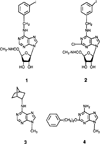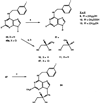Structure-activity relationships of 9-alkyladenine and ribose-modified adenosine derivatives at rat A3 adenosine receptors
- PMID: 7752196
- PMCID: PMC3445626
- DOI: 10.1021/jm00010a017
Structure-activity relationships of 9-alkyladenine and ribose-modified adenosine derivatives at rat A3 adenosine receptors
Abstract
9-Alkyladenine derivatives and ribose-modified N6-benzyladenosine derivatives were synthesized in an effort to identify selective ligands for the rat A3 adenosine receptor and leads for the development of antagonists. The derivatives contained structural features previously determined to be important for A3 selectivity in adenosine derivatives, such as an N6-(3-iodobenzyl) moiety, and were further substituted at the 2-position with halo, amino, or thio groups. Affinity was determined in radioligand binding assays at rat brain A3 receptors stably expressed in Chinese hamster ovary (CHO) cells, using [125I]AB-MECA (N6-(4-amino-3-iodobenzyl)adenosine-5'-(N-methyluronamide)), and at rat brain A1 and A2a receptors using [3H]-N6-PIA ((R)-N6-phenylisopropyladenosine) and [3H]CGS 21680 (2-[[[4-(2-carboxyethyl)-phenyl]ethyl]amino]-5'- (N-ethylcarbamoyl)adenosine), respectively. A series of N6-(3-iodobenzyl) 2-amino derivatives indicated that a small 2-alkylamino group, e.g., methylamino, was favored at A3 receptors. N6-(3-Iodobenzyl)-9-methyl-2-(methylthio)adenine was 61-fold more potent than the corresponding 2-methoxy ether at A3 receptors and of comparable affinity at A1 and A2a receptors, resulting in a 3-6-fold selectivity for A3 receptors. A pair of chiral N6-(3-iodobenzyl) 9-(2,3-dihydroxypropyl) derivatives showed stereoselectivity, with the R-enantiomer favored at A3 receptors by 5.7-fold. 2-Chloro-9-(beta-D-erythrofuranosyl)-N6-(3-iodobenzyl)adenine had a Ki value at A3 receptors of 0.28 microM. 2-Chloro-9-[2-amino-2,3-dideoxy-beta-D-5-(methylcarbamoyl)- arabinofuranosyl]-N6-(3-iodobenzyl)adenine was moderately selective for A1 and A3 vs A2a receptors. A 3'-deoxy analogue of a highly A3-selective adenosine derivative retained selectivity in binding and was a full agonist in the inhibition of adenylyl cyclase mediated via cloned rat A3 receptors expressed in CHO cells. The 3'-OH and 4'-CH2OH groups of adenosine are not required for activation at A3 receptors. A number of 2',3'-dideoxyadenosines and 9-acyclic-substituted adenines appear to inhibit adenylyl cyclase at the allosteric "P" site.
Figures








Similar articles
-
2-Substitution of N6-benzyladenosine-5'-uronamides enhances selectivity for A3 adenosine receptors.J Med Chem. 1994 Oct 14;37(21):3614-21. doi: 10.1021/jm00047a018. J Med Chem. 1994. PMID: 7932588 Free PMC article.
-
Interaction of 1,4-dihydropyridine and pyridine derivatives with adenosine receptors: selectivity for A3 receptors.J Med Chem. 1996 Jul 19;39(15):2980-9. doi: 10.1021/jm9600205. J Med Chem. 1996. PMID: 8709132 Free PMC article.
-
Synthesis and biological activities of flavonoid derivatives as A3 adenosine receptor antagonists.J Med Chem. 1996 Jun 7;39(12):2293-301. doi: 10.1021/jm950923i. J Med Chem. 1996. PMID: 8691424 Free PMC article.
-
The role of the adenosinergic system in lung fibrosis.Pharmacol Res. 2013 Oct;76:182-9. doi: 10.1016/j.phrs.2013.08.004. Epub 2013 Aug 28. Pharmacol Res. 2013. PMID: 23994158 Review.
-
Partial agonists for A(3) adenosine receptors.Curr Top Med Chem. 2004;4(8):855-62. doi: 10.2174/1568026043450989. Curr Top Med Chem. 2004. PMID: 15078216 Free PMC article. Review.
Cited by
-
Structure-activity relationships of truncated D- and l-4'-thioadenosine derivatives as species-independent A3 adenosine receptor antagonists.J Med Chem. 2008 Oct 23;51(20):6609-13. doi: 10.1021/jm8008647. Epub 2008 Sep 24. J Med Chem. 2008. PMID: 18811138 Free PMC article.
-
Truncated (N)-Methanocarba Nucleosides as A(1) Adenosine Receptor Agonists and Partial Agonists: Overcoming Lack of a Recognition Element.ACS Med Chem Lett. 2011 Aug 11;2(8):626-631. doi: 10.1021/ml200114q. ACS Med Chem Lett. 2011. PMID: 21858244 Free PMC article.
-
CXCL16 orchestrates adenosine A3 receptor and MCP-1/CCL2 activity to protect neurons from excitotoxic cell death in the CNS.J Neurosci. 2012 Feb 29;32(9):3154-63. doi: 10.1523/JNEUROSCI.4046-11.2012. J Neurosci. 2012. PMID: 22378888 Free PMC article.
-
Role of adenosine A3 receptors on CA1 hippocampal neurotransmission during oxygen-glucose deprivation episodes of different duration.Biochem Pharmacol. 2007 Sep 1;74(5):768-79. doi: 10.1016/j.bcp.2007.06.003. Epub 2007 Jun 7. Biochem Pharmacol. 2007. PMID: 17626785 Free PMC article.
-
A SURVEY OF NONXANTHINE DERIVATIVES AS ADENOSINE RECEPTOR LIGANDS.Nucleosides Nucleotides. 1996;15(1-3):693-717. doi: 10.1080/07328319608002416. Nucleosides Nucleotides. 1996. PMID: 27043138 Free PMC article.
References
-
- Daly JW, Jacobson KA. Adenosine receptors: Selective agonists and antagonists. In: Bellardinelli L, Pelleg A, editors. Adenosine and adenine nucleotides: From molecular biology to integrative physiology. Norwell, MA: Kluwer; 1995. pp. 157–166.
-
- Suzuki F, Shimada J, Shiozaki S, Ichikawa S, Ishii A, Nakamura J, Nonaka H, Kobayashi H, Fuse E. Adenosine A1 antagonists. 3. Structure activity relationships on amelioration against scopolamine- or N6-[(R)-phenylisopropyl]adenosine-induced cognitive disturbance. J. Med. Chem. 1993;36:2508–2518. - PubMed
-
- von Lubitz DKJE, Jacobson KA. Behavioral effects of adenosine receptor stimulation. In: Bellardinelli L, Pelleg A, editors. Adenosine and adenine nucleotides: From molecular biology to integrative physiology. Norwell, MA: Kluwer; 1995. pp. 489–498.
-
- Suzuki F, Shimada J, Mizumoto H, Karasawa A, Kubo K, Nonaka H, Ishii A, Kawakita T. Adenosine-A1 antagonists. 2. Structure-activity relationships on diuretic activities and protective effects against acute renal failure. J. Med. Chem. 1992;35:3066–3075. - PubMed
Publication types
MeSH terms
Substances
Grants and funding
LinkOut - more resources
Full Text Sources
Other Literature Sources
Chemical Information
